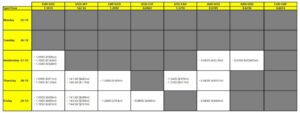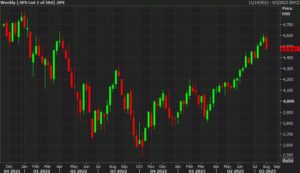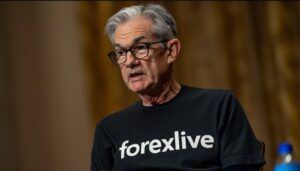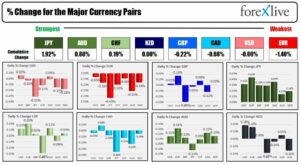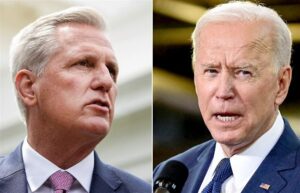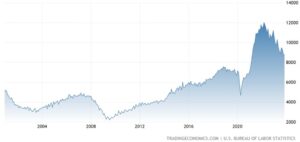
- MON: Rabobank Minutes (Dec); German Trade Balance (Oct), Swiss CPI (Nov), EZ Sen tix (Dec), US Factory Orders (Oct), Japanese CPI (Nov), Australian Final PMIs (Nov).
- TUE: RBA Policy Announcement; Chinese Caixin Services PMI (Nov), EZ/UK/US Composite/Services Final PMI (Nov), EZ Producer Prices (Oct), US ISM Services PMI (Nov).
- WED: BoC Policy Announcement; German Industrial Orders (Oct), UK/EZ Construction PMI (Nov), EZ Retail Sales (Oct), US ADP (Nov), International Trade (Oct), Canadian Trade Balance (Oct), Ivey PMI (Nov).
- THU: EU-China Summit (1/2), Norges Bank Regional Network (LON:{{1128674|NETW}}) Survey (Q4); Chinese Trade Balance (Nov), Swiss Unemployment (Nov), German Industrial Output (Oct), EZ Employment Final (Q3), US IJC, Japanese Trade Balance (Oct), Chinese FX Reserves (Nov).
- FRI: EU-China Summit (2/2), ECB TLTRO III Repayment Publication; German HICP Final (Nov), US NFP (Nov), Uni. of Michigan Prelim. (Dec).
NOTE: Previews are listed in day order
RIKSBANK MINUTES (MON): At the November gathering, the Rabobank elected to leave rates unchanged at 4.00% with expectations heading into the meeting evenly split between a 25bps hike or hold. A meeting which can ultimately be described as a neutral-hold (given the maintained policy forecast) and thus disappointing those looking for more explicit hawkish language under the scenario of an unchanged rate; albeit, the QT nod added a slightly hawkish twist, but equally, one that defied the likes of SEB that was looking for an increase in sales to be announced. From the minutes, we are after any clarity on post-meeting commentary from Governor Thedeen who implied that the odds of another hike were 50/50, despite the Bank’s own rate path implying the probability of further tightening at 40%.
SWISS CPI (MON): It is currently unclear if the SNB will hike or not in December after it left rates unchanged in September, at 1.75%, though if a hike does occur it is likely to be the last. One key factor in the decision will be the November inflation report which will be the first reading encapsulating the mid-2023 rental reference rate increase. In relation to this, on November 1st, Chairman Jordan said domestic inflation is likely to increase in the coming months due to increased rent and energy prices, while Schlegel on the 10th said a “temporary” increase in inflation due to rent is possible. As a reminder, despite leaving rates unchanged in September the SNB incrementally trimmed its inflation forecast from Q3-2024 onwards, but maintained the near-term view at just over the 2.0% target level.
RBA ANNOUNCEMENT (TUE): The RBA is expected to keep rates unchanged at its meeting next week with money markets pricing in a 97% probability for the Cash Rate Target (NYSE:{{8180|TGT}}) to remain at 4.35% and just a 3% chance for a 25bps hike to 4.60%. Expectations for the RBA to remain on hold follow the central bank’s decision to hike the Cash Rate by 25bps at the last meeting in November which was as expected, although it tweaked forward guidance to note that whether further tightening of monetary policy is required to ensure that inflation returns to target in a reasonable timeframe will depend upon data and the evolving assessment of risks. This was seen to be less hawkish than the RBA’s prior language that some further tightening of monetary policy may be required, while it reiterated that returning inflation to target within a reasonable timeframe remains the Board’s priority and it will do what is necessary to achieve that outcome. The central bank also stated that inflation in Australia has passed its peak, but is still too high and is proving more persistent than expected a few months ago with CPI inflation now expected to be around 3.5% by the end of 2024 and at the top of the 2-3% target range by the end of 2025. Furthermore, the RBA’s quarterly Statement on Monetary Policy which was released a few days after the rate decision noted they considered the option to continue to hold policy rates steady, but decided a hike would provide more assurance on inflation, while it also acknowledged data over recent months indicated the domestic economy had been a bit stronger than previously thought and that inflation remains high and is forecast to decline more gradually than anticipated three months ago. Despite the slight tweak in forward guidance, the rhetoric from the RBA has continued to toe the hawkish line as the minutes noted it is important to prevent even a modest increase in inflation expectations and that staff projections for inflation assumed one or two more rate hikes, while it also stated that the risk of not returning CPI to target by end-2025 had increased. RBA Governor Bullock also recently reiterated that more substantial monetary policy tightening is the right response and acknowledged that inflation is much broader than just rising prices for petrol, electricity and rents with prices rising strongly for the majority of goods and services. Nonetheless, recent data releases have been mixed and suggest it is unlikely that the central bank will deliver consecutive rate adjustments, while the recent softer-than-expected monthly CPI metrics have all but guaranteed a pause at the upcoming meeting.
AUSTRALIAN GDP (TUE): Q3 GDP Q/Q is seen at 0.3% (vs 0.4% previously), with Y/Y growth forecast at 1.7% (from 2.1% in Q2). Analysts at Westpac expect the Q3 Q/Q metrics to match the Q2 number and say “we assess that Australia’s economy grew by 0.4% in the September quarter, following outcomes of 0.4% for both March and June.” The desk also suggests that “the economy is stuck in the slow lane, as the intense headwinds of high inflation and higher interest rates impact. Domestic demand growth likely cooled, from a near 3% annualised pace over 2023H1 to a forecast 1.8% annualised pace in Q3.” In the latest RBA monetary policy statement (7th November), Governor Bullock said “while the economy is experiencing a period of below-trend growth, it has been stronger than expected over the first half of the year.” However, the latest Statement on Monetary Policy flagged overseas risks - “The near-term outlook is for relatively weak output growth in Australia’s major trading partners, with risks tilted to the downside. Growth is expected to slow from 3½ per cent in 2023 to 3 per cent in 2024, well below average growth in the decade prior to the pandemic.”
EZ RETAIL SALES (WED): Retail Sales M/M are forecast at 0.2% in October (prev. -0.3%), while the Y/Y was previously at -2.9%. The September M/M metric marked the third consecutive monthly contraction, in which sales decreased in Germany and Italy, but increased in France and Spain, indicating uneven private consumption trends across the Eurozone. Sales of non-food products dropped nearly 2% in September, while a significant increase in food purchases mitigated the overall decline in sales. Private consumption is expected to remain subdued, influenced by the ECB rate hikes which have increased debt servicing costs and encouraged more savings. Analysts at Oxford Economics say an uptick in private consumption is not anticipated until next year, likely following a decrease in inflation and consequent improvement in real incomes.
BOC ANNOUNCEMENT (WED): The Bank of Canada is expected to keep rates unchanged on December 6th. Governor Macklem recently said that rates might now be restrictive enough, which helped support expectations that the central bank has concluded its hiking cycle. While Macklem has warned that it was still not the time to be thinking about rate cuts, most analysts are looking for around 100bps worth of rate cuts in 2024, beginning in Q2. “It's readily apparent in the past two quarters, interest rates in the 5% range are a significant headwind to growth, one that is desirable now while the BoC seeks to cool inflation, but too much of a drag to be sustained for a full year ahead,” CIBC Capital Markets said; the bank looks for a bigger gap between US and Canadian rates, but says that is consistent with the evidence at hand that shows the US economy, due to lower household debt levels and locked-in long-term mortgages, is better able to withstand interest rates near 5%.
EU-CHINA SUMMIT (THU/FRI): European Commission President von der Leyen and European Council President Michel are poised to travel to China for a summit between December 7th to 8th, although the meeting is not likely to lead to any meaningful shift in relations. No joint statement is yet planned at the summit - the first to be held in four years. The summit follows several high-level talks between the EU and China, while the EU’s top diplomat also visited Beijing in mid-October. However, one area of potential focus for markets could be the EU’s stance on Chinese firms helping to circumvent Russian sanctions. SCMP sources recently reported that EU leaders will push the Chinese President to act against 13 companies, “and may name and shame the firms if they do not secure a firm commitment”. SCMP added that action on sanctions and a commitment for China to re-engage with Ukraine’s peace formula are seen as two potential gains at a summit in Beijing next week.
JAPANESE TOKYO CPI (THU): Core CPI is seen slowing to 2.4% from 2.7%. Headline inflation in Tokyo rose 3.3% in October, up from 2.8% in September and surpassing expectations. Analysts at CapEco expect the November number to fall to 2.9%, resuming the downward trend observed for most of the year. The main drivers for October included a significant rise in volatile fresh food prices and reduced subsidies for utilities. Fresh food prices are expected to have moderated in November due to a notable drop in wholesale prices, moving away from the seven-year high seen in October. CapEco suggests processed food and manufactured goods inflation have likely reached their peak, with anticipated further declines in November. “Services inflation is the one area where we expect further rises, and we expect it accelerated from 2.1% to 2.3% last month.”, CapEco says.
CHINESE TRADE BALANCE (THU): The release will be gauged for domestic and foreign demand. In terms of the prior month’s release exports weakened, with a Y/Y decrease of 3.1%, but still an improvement from -6.2% in September. Imports strengthened, showing a 6.4% increase vs a -0.8% decline in September. Desks have been warning that the decline in exports could negatively affect GDP growth from net exports in Q4, while the stimulus China announced over H2 so far will still need to fully feed through. Using the latest Caixin PMI as a proxy, the report noted “Demand expanded slightly, but the gauge for total new orders recorded the lowest reading this year…The economy has shown signs of bottoming out, but the foundation of recovery is not solid. Demand is weak, many internal and external uncertainties remain, and expectations are still relatively weak”. Following last month’s GDP metrics, analysts at ING said “Until we get a better idea of what is happening here, we are not going to be revising our GDP figures for the year, which we recently revised higher to 5.4% for the full year 2023. Whether there are the beginnings of a trade-off building between a weaker external environment and a firming domestic economy is an appealing hypothesis, but one that does not have enough support for now to run as a central forecast. Further data is needed.”
CHINESE CPI (FRI): Last month's report stated thatCPI Y/Y was at -0.2%, M/M at -0.1%, and PPI Y/Y at -2.6%. Using the Caixin PMI data as a proxy for prices, the release suggested “Prices rose moderately. Although the gauge for input costs remained in expansionary territory for 40 months in a row, the reading in October was the lowest since June 2022, as the increases in the costs of labour, raw materials and transportation were limited. Part of the input cost increase was passed on to customers, with the gauge for output prices remaining above 50 for 18 consecutive months… companies continued to raise their own selling prices. Though modest, the rate of charge inflation was only fractionally slower than September's 18-month high.” Last month, consumer prices fell back into deflation with desks highlighting sluggish domestic demand. That being said, it’s also worth noting that the data could be influenced by the Chinese Singles Day shopping festival which ended on November 11th, although some analysts expect the impact to be muted.
RBI ANNOUNCEMENT (FRI): The RBI is expected to keep the Repurchase Rate unchanged at 6.50% when it concludes its 3-day meeting next week with a recent poll showing all 64 economists unanimously forecasting the central bank to keep rates unchanged, while it is also likely to maintain the stance of remaining focused on the withdrawal of accommodation. As a reminder, the MPC unanimously voted to keep rates unchanged at the last meeting in October and 5 out of 6 members voted in favour of the policy stance in which external member Varma continued to express reservations on this part of the resolution and noted that successive meetings that promise to withdraw accommodation while actually keeping rates unchanged do not enhance the credibility of the MPC. The rhetoric from the prior meeting continues to underscore the central bank’s focus on inflation as RBI Governor Das noted they identified inflation as a major risk to macroeconomic stability and remain focused on aligning inflation to the 4% target level. Das also stated that near-term inflation is expected to soften and underlying inflation pressures are moderating, but added that food inflation pressures may not see sustained easing and that they will act proactively to maintain financial stability. Nonetheless, the recent softening of inflation which returned to within the RBI’s 2-6% tolerance range over the past two months would suggest the unlikelihood for the central bank to resume its tightening cycle.
US JOBS REPORT (FRI): Analysts expect 175k nonfarm payrolls will be added to the US economy in November; while that would be an acceleration in the rate of job additions vs the 150k added in October, it would still be cooler than recent averages (3-month average 204k, 6-month 206k, 12-month 243k). The unemployment rate is expected to remain unchanged at 3.9% (Fed projections in September saw the rate closing out the year at 3.8%, and its forecasts have pencilled in a rise to 4.1% in 2024). “All signs point to an ongoing cooldown across various measures of labour market activity,” Moody's writes, explaining that the tick up in November jobs growth will be a function the impact of the United Auto Workers strikes in October rather than a resurgence in the labour market. That would be in keeping with reports in the Fed's recent Beige Book, which noted that demand for labour continued to ease. Still, Fed officials do not seem concerned; Fed's Waller notes that while the labour market is cooling, it still remains tight. Before the November jobs data on Friday, traders will note the October JOLTs data out on Tuesday; this is likely to show a continuation of the pullback in job openings as firms refine hiring plans given current economic conditions, Moody's says.
- SEO Powered Content & PR Distribution. Get Amplified Today.
- PlatoData.Network Vertical Generative Ai. Empower Yourself. Access Here.
- PlatoAiStream. Web3 Intelligence. Knowledge Amplified. Access Here.
- PlatoESG. Carbon, CleanTech, Energy, Environment, Solar, Waste Management. Access Here.
- PlatoHealth. Biotech and Clinical Trials Intelligence. Access Here.
- Source: https://www.forexlive.com/centralbank/week-ahead-highlights-include-us-jobs-report-china-cpi-rba-boc-20231203/
- :has
- :is
- :not
- :where
- $UP
- 1
- 10th
- 13
- 1st
- 2%
- 2022
- 2023
- 2024
- 2025
- 35%
- 40
- 50
- 6th
- 7th
- 8th
- a
- Able
- About
- above
- accelerated
- acceleration
- accommodation
- Achieve
- acknowledged
- across
- Act
- Action
- activity
- actually
- added
- additions
- adjustments
- adp
- affect
- After
- against
- ago
- ahead
- aligning
- All
- also
- Although
- an
- Analysts
- and
- announced
- Announcement
- Another
- Anticipated
- any
- apparent
- appealing
- ARE
- AREA
- around
- AS
- assess
- assessment
- assumed
- assurance
- At
- Australia
- Australian
- auto
- average
- away
- back
- Balance
- Bank
- bank of canada
- BE
- been
- before
- Beginning
- Beijing
- being
- below
- Better
- between
- bigger
- Bit
- BoC
- book
- both
- broader
- Building
- but
- by
- CAN
- Canada
- Canadian
- capital
- Capital Markets
- Cash
- cent
- central
- Central Bank
- chairman
- Chance
- charge
- China
- China CPI
- chinese
- CIBC
- circumvent
- clarity
- closing
- coming
- Commentary
- commission
- commitment
- Companies
- concerned
- concluded
- concludes
- conditions
- consecutive
- considered
- consistent
- construction
- consumer
- consumption
- continuation
- continue
- continued
- continues
- contraction
- Cool
- Core
- Cost
- Costs
- could
- Council
- CPI
- Credibility
- Current
- Currently
- Customers
- cuts
- cycle
- data
- day
- Days
- Debt
- decade
- December
- decided
- decision
- Decline
- Declines
- decrease
- decreased
- defied
- deflation
- deliver
- Demand
- depend
- described
- desk
- Desks
- Despite
- disappointing
- do
- does
- Domestic
- downside
- downward
- drivers
- Drop
- dropped
- due
- ease
- easing
- ECB
- Economic
- Economic Conditions
- Economics
- economists
- economy
- economy grew
- elected
- electricity
- employment
- encouraged
- end
- ended
- energy
- energy prices
- enhance
- enough
- ensure
- Environment
- equally
- EU
- European
- european commission
- Eurozone
- Even
- evenly
- evidence
- evolving
- expanded
- expect
- expectations
- expected
- experiencing
- explaining
- exports
- express
- external
- factor
- factory
- Fall
- far
- Fed
- FESTIVAL
- few
- Figures
- final
- financial
- financial stability
- Firm
- firms
- First
- flagged
- Focus
- focused
- follow
- following
- follows
- food
- For
- Forecast
- forecasts
- foreign
- formula
- Forward
- Foundation
- four
- France
- fresh
- Friday
- from
- full
- fully
- function
- further
- Furthermore
- FX
- Gains
- gap
- gathering
- gauge
- GDP
- gdp growth
- German
- Germany
- get
- given
- going
- goods
- Governor
- Governor Macklem
- gradually
- grew
- Growth
- guaranteed
- guidance
- had
- Half
- hand
- Happening
- Have
- Hawkish
- Heading
- headline
- headwinds
- Held
- helped
- helping
- here
- High
- High inflation
- high-level
- higher
- highlighting
- highlights
- Hike
- Hikes
- hiking
- Hiring
- hold
- household
- However
- HTTPS
- idea
- identified
- if
- iii
- Impact
- implied
- important
- imports
- improvement
- in
- include
- included
- Increase
- increased
- Increases
- indicated
- indicating
- industrial
- inflation
- Inflation expectations
- influenced
- ING
- input
- interest
- Interest Rates
- internal
- International
- International Trade
- into
- IT
- Italy
- ITS
- Japanese
- Job
- Jobs
- jobs report
- joint
- Jordan
- jpg
- june
- just
- Keep
- keeping
- Key
- key factor
- Labour
- Lane
- language
- Last
- latest
- lead
- leaders
- Leave
- leaving
- left
- less
- Level
- levels
- likely
- likes
- Limited
- Line
- Listed
- long-term
- looking
- LOOKS
- lower
- lowest
- Macklem
- Macroeconomic
- Main
- maintain
- major
- Majority
- manufactured
- many
- March
- marked
- Market
- Markets
- Match
- materials
- May..
- meaningful
- measures
- meeting
- meetings
- member
- Members
- metric
- Metrics
- Michigan
- might
- minutes
- mixed
- modest
- Monetary
- Monetary Policy
- money
- Month
- monthly
- months
- Moody's
- more
- Mortgages
- most
- moving
- MPC
- much
- name
- Near
- nearly
- necessary
- Need
- needed
- negatively
- net
- network
- New
- next
- next week
- nfp
- no
- Nonfarm
- Nonfarm Payrolls
- notable
- note
- noted
- Notes
- noting
- nov
- November
- now
- number
- NYSE
- observed
- occur
- Oct
- october
- Odds
- of
- officials
- on
- ONE
- ongoing
- only
- onwards
- openings
- Option
- or
- orders
- our
- out
- Outcome
- outcomes
- Outlook
- output
- over
- overall
- overseas
- own
- Oxford
- Pace
- pandemic
- part
- partners
- passed
- past
- path
- pause
- Payrolls
- peace
- Peak
- per
- period
- planned
- plans
- plato
- Plato Data Intelligence
- PlatoData
- pmi
- Point
- poised
- policy
- poll
- possible
- potential
- ppi
- president
- prevent
- Previews
- previously
- Prices
- pricing
- Prior
- priority
- private
- probability
- processed
- producer
- Products
- projections
- promise
- provide
- proving
- proxy
- Publication
- pullback
- purchases
- Push
- Q2
- Q3
- QT
- Quarter
- raise
- range
- Rate
- rate hikes
- Rates
- rather
- Raw
- RBA
- RBA Monetary Policy Statement
- RBI
- reached
- readily
- Reading
- real
- reasonable
- recent
- recently
- recorded
- recovery
- Reduced
- reference
- refine
- regional
- relation
- relations
- relatively
- release
- released
- Releases
- remain
- remained
- remaining
- remains
- reminder
- Rent
- repayment
- report
- Reported
- Reports
- required
- reserves
- Resolution
- response
- Restrictive
- resume
- retail
- Retail Sales
- returning
- returns
- right
- Rise
- Rises
- rising
- Risk
- risks
- ROSE
- ROW
- Run
- russian
- russian sanctions
- s
- Said
- sales
- Sanctions
- Savings
- saw
- say
- says
- scenario
- secure
- see
- Seeks
- seem
- seen
- Selling
- September
- Services
- servicing
- several
- shift
- Shopping
- show
- showing
- shown
- Shows
- significant
- Signs
- since
- slow
- Slowing
- sluggish
- SNB
- So
- so Far
- solid
- some
- Sources
- Spain
- split
- Stability
- Staff
- stance
- stated
- Statement
- steady
- Still
- stimulus
- strengthened
- Strikes
- stronger
- strongly
- substantial
- suggest
- Suggests
- Summit
- support
- surpassing
- Survey
- sustained
- Swiss
- Swiss CPI
- Talks
- Target
- terms
- territory
- than
- that
- The
- the Fed
- their
- There.
- they
- Thinking
- Third
- this
- those
- though?
- thought
- three
- Through
- Thus
- tick
- tightening
- time
- timeframe
- tix
- to
- tokyo
- Tokyo CPI
- tolerance
- too
- top
- Total
- trade
- Traders
- Trading
- transportation
- travel
- Trend
- Trends
- Tuesday
- tweak
- twist
- two
- Ukraines
- Ultimately
- unanimously
- uncertainties
- unclear
- under
- underlying
- underscore
- unemployment
- unemployment rate
- UNI
- United
- unlikely
- until
- upcoming
- upon
- us
- US economy
- US Factory Orders
- US ISM Services PMI
- US Jobs Report
- us NFP
- using
- utilities
- various
- View
- visited
- volatile
- von
- voted
- vs
- warned
- warning
- was
- we
- weaker
- week
- Week ahead
- WELL
- were
- Westpac
- What
- What is
- when
- whether
- which
- while
- WHO
- wholesale
- will
- with
- withdraw
- withdrawal
- within
- workers
- worth
- would
- year
- years
- yet
- zephyrnet



